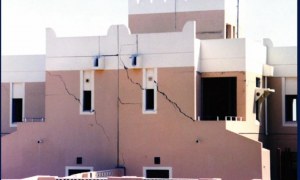🕑 Reading time: 1 minute
Rock reinforcements are additional supports provided to the rock structures to improve its stability and load carrying capacity. Rock reinforcement utilizes the inherent property of the rock structures to behave like a self-supporting single unit. Rock reinforcements can be provided in the form of rock bolts, rock anchors or rock dowels.
The need and types of rock reinforcement are briefly explained in this article.
Contents:
Need for Rock Reinforcement
Rocks may undergo widespread fractures that result in falling out of individual rock blocks leading to slope failure. Use of rock reinforcement helps to connect these discontinuities in the rock and helps the rock mass to behave as a single unit. These discontinuities are connected together by the method of bolting which results in the alteration of stresses throughout the rock mass.
Types of Rock Reinforcement
The support provided by rock reinforcements can be either an active type or passive type. In the case of active support, a predetermined load is imposed on the rock surface at the time of installation. In passive type, a load is developed when the rock mass deforms or displaces.
Different types of rock reinforcement used in rock engineering applications are:
- Rock Bolts
- Rock Anchors
- Rock Dowels
1. Rock Bolts
This type of rock reinforcement is mostly held at the end of the borehole. They are steel rods which are grouted into the rock. These have a grout anchor or friction on the rock. Once the anchorage is attained, it is tensioned and a compressive force is induced into the surrounding ground.

The induced axial force acts on the rock-mass discontinuities which increases the shear capacity of the mass. This shear capacity is induced through the pre-tensioning of the bolt. The rock bolts used can be the following types :
- Grouted rock bolts
- Grouted cable bolts
- Friction anchor rock bolts
- Mechanically anchored rock bolts
2. Rock Dowels
This is a passive type of rock reinforcement which requires a ground displacement for its activation. When the discontinuities in the rock mass are subjected to displacement, the dowel experiences both shear and tensile stresses.

3. Rock Anchors
This method of rock reinforcement makes use of compressive or uplift force in order to stabilise any structure or rock mass present in the ground or underground. These are high tensile strength bars. These are pre-tensioned by anchoring at the end of the borehole.
Rock anchors can be either un-tensioned anchors or tensioned anchors. An un-tensioned anchor is a passive type rock reinforcement which develops tension with the deformations. The support increases with the increase in development. A tensioned anchor is an active type which supports completely and immediately after installation. Failure of the rock mass due to shear is resisted by rock anchors.
Applications of Rock Reinforcement
Rock reinforcement provides safety and temporary supports for many underground construction works. The applications of rock reinforcement are mentioned below.
- Rock reinforcement is used to pre-load the foundation.
- It can be used to provide a reaction during the pile load test.
- Rock reinforcements (Rock Anchors) are used to anchor the suspension cables and guy wires for the bridges.
- It helps to tie down the wire cables with the foundation under the sea.
- Uplift caused in transmission towers, foundation and hydraulic structures due to lateral forces is resisted by rock reinforcement.
- Rock anchors can be used to support sheet piles.
Also Read: Sheet Pile Walls
Also Read: Pile load test


